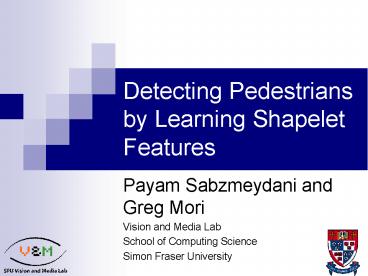Detecting Pedestrians by Learning Shapelet Features - PowerPoint PPT Presentation
Title:
Detecting Pedestrians by Learning Shapelet Features
Description:
Edgelet features (Wu and Nevatia, ICCV 2005) ... Find those which discriminate between pedestrian and background classes. 14. AdaBoost Algorithm ... – PowerPoint PPT presentation
Number of Views:697
Avg rating:3.0/5.0
Title: Detecting Pedestrians by Learning Shapelet Features
1
Detecting Pedestrians by Learning Shapelet
Features
- Payam Sabzmeydani and Greg Mori
- Vision and Media Lab
- School of Computing Science
- Simon Fraser University
2
Problem
- Given a still image, we want to find and locate
the pedestrians in the image - Clothing (color, appearance)
- Body pose
- Applications
- Automated surveillance systems
- Image search and retrieval
- Robotics
- Intelligent vehicles
3
Problem
4
Problem
- Classification-based detection
- Classify a window as pedestrian or non-pedestrian
- Search exhaustively the scale-space image
- Different cues
- Wavelet coefficients (Mohan et al., PAMI 2001)
- Oriented gradients (Dalal and Triggs, CVPR 2005)
- SIFT features (Leibe et al., CVPR 2005)
- Edgelet features (Wu and Nevatia, ICCV 2005)
- Shapelet features (Sabzmeydani and Mori, CVPR
2007)
5
Datasets
- MIT Standing pose, simple background, no
occlusion - INRIA Standing pose, complex background,
partial occlusions
6
Previous Work
- Dalal Triggs (CVPR 2005)
- HOG features SVM
7
Previous Work
- Wu Nevatia (ICCV 2005)
- Edgelet features short line and curve segments
- AdaBoost
8
Our Method
- Compute low-level gradient features
- Oriented filter responses
- Learn mid-level features for detecting
pedestrians - Shapelet features
- Build final classifier from shapelet features
9
Low-level Features
- Filter responses
- Image gradient in different directions
10
Low-level Features
- Smoothed gradient responses in different
directions
11
Shapelet Features
- A weighted set of low-level gradient features
inside a sub-window of the detection window - Characteristics
- Simple and low-dimensional
- Learned exclusively for our object classes
- Highly discriminative
- Local effective area useful to model separate
parts instead of the whole body
12
Shapelet Features
13
Learning Shapelet Features
- Learned using AdaBoost (Viola and Jones, 2001)
- Extract low-level features in sub-window
- Select subset of features using AdaBoost
- Find those which discriminate between pedestrian
and background classes
14
AdaBoost Algorithm
W
w
15
Low-level features as weak classifiers
- Each low-level feature can provide us many weak
classifiers - AdaBoost will combine weak classifiers to form a
better classifier
16
Shapelet features
- Train classifiers in sub-windows
- Use the output of a classifier as the shapelet
feature response
17
Shapelet Features
18
Shapelet Features
19
Final Classifier
- Take all shapelet features
- Learned at many sub-windows of detection window
- Run AdaBoost again to select weighted subset of
shapelet features for final classifier
20
Final Classifier
21
Shapelet Feature Size
- Small, Medium, and Large features
- Capture different scales of information
22
Normalization
- Why normalize?
- Different lighting, shadows, different contrast,
- How to normalize?
- Per shapelet feature L2-norm
23
Normalization
24
Results on INRIA Dataset
25
Error examples
- Most non-pedestrian-like pedestrians (false
negatives) - Most pedestrian-like non-pedestrians (false
positives)
26
Future work
- Detecting other objects
- Use image context or segmentation
- Pyramid of features
27
(No Transcript)
28
References
- N. Dalal and B. Triggs. Histograms of oriented
gradients for human detection. CVPR 2005. - B. Wu and R. Nevatia. Detection of multiple,
partially occluded humans in a single image by
bayesian combination of edgelet part detectors.
ICCV 2005. - P. Viola and M. Jones. Rapid object detection
using a boosted cascade of simple features. SCTV
2001.
29
Problem
30
Problem
31
Bootstrapping
32
Mid-level Features



























![Top 5 Machine Learning Frameworks[2020] PowerPoint PPT Presentation](https://s3.amazonaws.com/images.powershow.com/9437255.th0.jpg?_=20200508073)



